
Yoga Approaches for the Three Doshas
Once you establish rapport with your clients, it is possible to expand the wisdom of Ayurveda into other aspects of daily living. Every day we are faced with choices that affect our overall sense of harmony—from what we eat to how we exercise and how we spend our leisure time. Many individuals feel wonderful just after a massage or yoga session, but they quickly lose this equilibrium due to poor nutritional choices, lack of appropriate exercise, or a hectic lifestyle.
The beauty of Ayurveda is that it provides a scientific approach that teaches us how to make daily choices to increase peace and maintain sustained wellness for ourselves and clients. The key to understanding how to navigate our way through these daily decisions is to know who we are—which, according to Ayurveda, means understanding our doshic constitution. With this knowledge we can build a lifestyle that complements our doshic body type, bringing Ayurveda into our lives for the duration of our lives.
The wellness program introduced in this section is comprised of three components—yoga postures for home practice, nutritional recommendations, and lifestyle tips. Providing simple and clear recommendations to our clients in these areas will support their overall health and well-being, as well as establish a stronger therapeutic rapport.
Individuals of a predominantly vata nature benefit from a yoga practice that is slow, gentle, and meditative in approach. The primary focus of the practice should be on establishing balance and core strength rather than developing flexibility. Although flexibility often comes naturally for the slender and wiry vata body type, individuals of this nature should avoid overflexing or overextending the body. Overstretching can have an adverse effect and may stimulate the sympathetic nervous system, the aspect of the nervous system that prepares the body for action.
Vata postures should aim to tone the parasympathetic nervous system, which produces a calming effect on the body and mind—something most vatas need. Yoga postures should therefore be selected for their ability to build strength, stability, and steadiness. Gentle yoga classes that include plenty of time for deep breathing and relaxation are preferable to those that cause exertion or pain.
Vata Yoga Series
The yoga exercises that balance and restore vata include motionless balancing postures, such as forward bends, and standing balancing poses; sitting postures and seated spinal twists also help to slow down and ground vata. Mild backbends are good, in moderation, as they help to relieve vata stiffness and tension in the sacrum and along the spine. Mild inversions can be helpful for nourishing the upper extremities and brain, but they can cause exertion or fatigue if done in excess.
Vata individuals should take care to avoid abrupt movements, jumping, or significant sweating during a session—leave that to the kaphas! Rather, vatas should focus on maintaining even and consistent energy throughout the duration of a yoga session. Yoga postures should be held long enough to slow the mind and promote deep breathing, but they should never cause exertion or pain. Vatas should also make sure to practice all exercises evenly on both sides of the body to instill regularity and balance, qualities often lacking in their practice and lifestyle.
As discussed in chapter 3, each dosha is associated with a region of the body in which tensions accumulate; these areas of accumulation therefore may require special attention during a yoga session. The organs and regions of the body where vata types tend to be sensitive include the colon (large intestine), spine, back muscles, pelvis, thighs, kidneys, ears, bones, and hollow and dry cavities of the body.
Every yoga session personalized for a vata constitution should be completed with a generous period of relaxation in Savasana, with the practitioner lying on the back and breathing deeply into the abdomen. Vata individuals will need at least fifteen minutes of relaxation for a ninety-minute yoga session. Pillows, blankets, eye pillows, and any props that help to comfort and warm the vata individual are recommended.
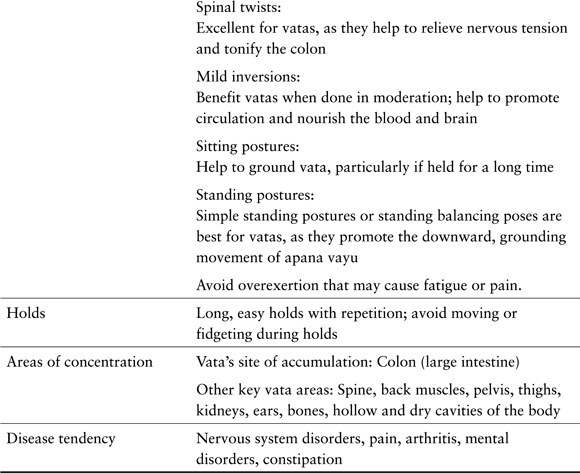
Yoga postures for vatas emphasize balance, gentle stretches, nurturing poses, and long periods of relaxation.
Vayus for the Vata Constitution
As we mentioned in chapter 3, an understanding of the five directions of prana, the vayus, is a powerful tool for balancing one’s doshic type. A well-balanced yoga program will attend to all five vayus. Yet there are particular vayus that are specifically good for each doshic type. Sometimes simply being aware of the direction of the vayus can help to calm, increase, or channel energy to specific areas of weakness or low energy within the body.
Although vata individuals actually benefit from awakening a subtle combination of most of the vayus, the best vayus for these individuals are the inward movement of prana and the downward movement of apana. The one exception is the upward movement of udana vayu, which in excess can destabilize and imbalance vata.
A vata yoga series should include a generous proportion of forward bends, which recharge the pranic battery and have a revitalizing effect on the body. Pranayama breathing exercises, such as Anuloma Viloma, help to renew and balance vata energy, which is often erratic or low. The downward movement of apana helps to ground vata and is activated by mild spinal twists, standing postures, and relaxation poses.
YOGA APPROACH FOR PITTAS
The fiery pitta is best suited to a cooling, soft, relaxing approach to yoga that diffuses excessive heat or irritability in the body. Postures should be nonvigorous, have a cooling effect on the head and blood, and aim at calming the heart.
Pitta individuals have the drive and willpower to excel in a yoga practice, which can result in a tendency toward becoming overly competitive and serious in the practice. Individuals of this nature will benefit from a noncompetitive atmosphere that allows them to let go of control and effort. Moderate hatha yoga classes that focus on alignment would be preferable to the more aerobic forms of yoga performed in a heated room or those that cause excessive sweating. The biggest challenge facing pittas is to let go of control and apply their powerful will to creating a soft and gentle approach to practice.
Pitta Yoga Series
The pitta yoga series includes plenty of sitting and standing forward bends, which have a cooling and surrendering effect on the body. Most sitting postures are good for pitta individuals, especially bound poses such as Lotus or Reclining Hero, which tend to reduce circulation and refocus the body’s attention to the abdomen. This allows for efficient and proper digestion, pitta’s major function in the body. Spinal twists and cooling standing postures, such as Triangle, help to drain excess heat from the body.
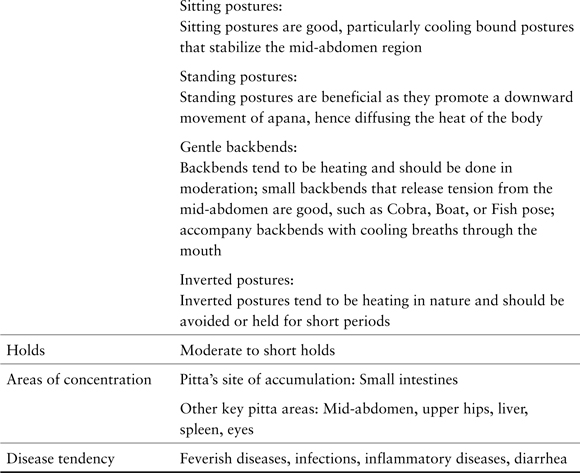
The heat is released via the downward flow of apana vayu. Although some backward stretching should be included as a counterforce, deep backbends such as Wheel are heat producing and so should be avoided. This is also true of inversions, such as Headstand, which increase the flow of blood upward, causing an accumulation of heat in the upper extremities and head. Shoulderstand can be practiced in moderation, however, as the bandha at the throat prevents the heating solar energy of the navel from flowing to the head. The cooling pranayama techniques of sithali and sitkari, described in chapter 7, can be combined with heating postures to provide balance.
All postures should be held for a short to moderate length of time, to avoid exertion and heat accumulation. This may disappoint some of you pittas, who love to push yourself to the limit and will settle for nothing less than near perfection. After trying this pitta-calming approach for a while, notice whether that lingering feeling of frustration once experienced following an intense yoga session remains. If you are a pitta individual and leave a yoga class red in the face or with pink splotches on your skin, this is a sign that you are probably overheating yourself. Remember that yoga is a chance to remove ourselves from the competitive world that surrounds us—so relax, let go, and have fun! As we discussed in chapter 3, pitta’s main site of accumulation in the body is the small intestines and mid-abdomen. A pitta approach to yoga should therefore draw attention to the abdominal region and aim to balance the body’s digestive fire, or agni, which is ruled by pitta. This digestive fire governs the body’s ability to metabolize and absorb all of the physical and mental substances consumed by an individual. Other pitta regions of the body that may harbor tensions or sensitivities include the upper hips, liver, spleen, and eyes.
A pitta yoga session should be followed by a final relaxation that is moderate in length, about ten minutes for a ninety-minute yoga session. An eye pillow made of flax seed and lavender helps to cool the pitta mind; cushions placed under the knees can relieve tension in the pelvic region, where pitta tends to accumulate.
Vayus for the Pitta Constitution
As has been previously noted, the most cooling of all the vayus is the linear movement around the abdomen known as samana vayu. When the body’s energy is centered around the navel area, it creates a contracting force that channels excess heat into the digestive track for metabolism and absorption.
A pitta yoga practice therefore benefits most from stabilizing postures that increase samana vayu, such as sitting postures and bound poses. One has only to picture the classical Indian posture for eating—sitting cross-legged on the floor in front of a wide banana-leaf plate—to understand how important samana vayu is to the digestive process. Another posture known in India for stimulating digestion is Reclining Hero pose, which is often practiced after completing a meal to help sustain the digestive fire.
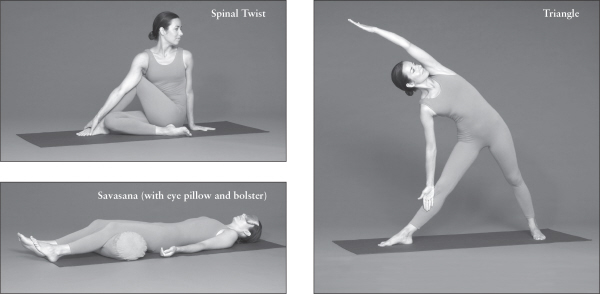
Yoga postures for pittas emphasize forward bends, moderate stretches, and a cooling and non-competitive approach.
While vata and pitta individuals need to slow down and relax the body, the already well-relaxed kapha individual benefits from a stimulating yoga approach that is fiery, invigorating, and energizing. Of all the body types, kaphas benefit most from aerobic, heating styles of yoga, such as Bikram, Ashtanga, or Power Yoga. These approaches tend to break up stagnation and release toxins from the body, generating a cleansing process that is highly tonifying for kapha congestion and sluggishness. Postures in this series tend to heat the body, open the chest, develop flexibility, promote blood circulation, and increase heart capacity.
But before entering into a rigorous workout, kaphas should warm up the body properly and proceed with determined effort. Postures should be held for a long period of time, causing some exertion and sweating. The main challenge for kaphas is to muster the willpower to maintain a regular practice—but once they are going they gain much benefit and enjoyment from a regular practice.
Kapha Yoga Series
Kaphas benefit most from postures that promote circulation and mobility and demand more effort from the practitioner. Standing postures wake up the body and counter the kapha tendency toward immobility, inertia, and drowsiness. Backbends are an excellent method of opening the congested kapha chest and increasing circulation from the heart outward to all the extremities. Backbends that are performed on the belly, such as Bow, Boat, or Cobra, are particularly good as they help to stimulate the sluggish kapha digestive fire, which can lead to low metabolism and loss of appetite. Inversions increase the flow of energy to the chest and head, waking up the senses and brain. Spinal twists can help to promote digestion, although standing spinal twists are preferred. Sedentary sitting, prone, or lying postures should be avoided, as they increase the inactivity and stability already well established in kapha types. Forward bends, which contract the chest, may aggravate kapha congestion and should therefore also be avoided.
Kapha’s main site of accumulation in the body is the stomach. Other areas of the body that kaphas may want to focus on during a yoga session include the chest, lungs, throat, nose, and sinuses, where mucus tends to accumulate. Yoga postures should aim to open and clear these areas, promoting a discharge of excess mucus.
In contrast to vatas and pittas, kaphas require the shortest period of relaxation after a yoga session. Five to seven minutes of relaxation is sufficient relaxation following a ninety-minute yoga practice. Kaphas will want to use as few pillows and blankets as necessary to avoid falling fast asleep!
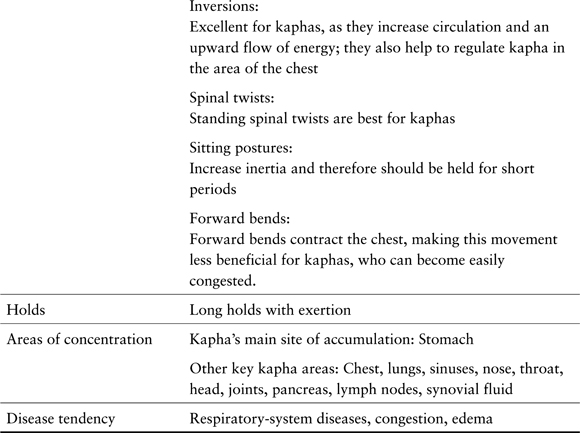
Vayus for the Kapha Constitution
The stable, earthy nature of kaphas leads to a heavy and stagnant energy flow. For this reason, the vayus that most benefit a kapha practice are those that draw the energy up and out.
The upward movement of udana vayu is activated by inverted postures and poses, in which the arms or legs are raised above the head. This encourages a flow of oxygen and nutrients to the diaphragm, sinuses, and brain. Vyana vayu increases circulation to all parts of the body and is activated by backbends, extensions, and aerobic activities.

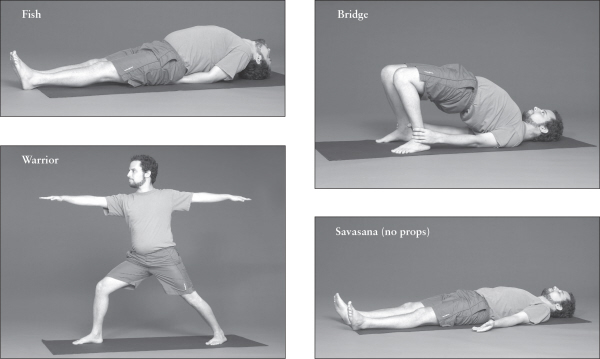
Yoga postures for kaphas emphasize chest-openers, deep backbends, and invigorating standing postures with shorter periods of relaxation.
Within the disciplines of yoga and Ayurveda, meditation is considered the main tool for healing the mind. A regular meditation practice can remove the mental root of the disease process; meditation has the greatest chance of success when the mode is suited to one’s doshic type. However, not everyone is ready for meditation; in many cases it may be better to begin with a yoga practice or breathing exercise.
Never try to persuade your recipient to practice a form of meditation that makes him or her uncomfortable, even if you sense that it would be of benefit. If any of your recipients are already well established in a meditation practice, avoid persuading them to change techniques according to their doshic type.
Most importantly, we as practitioners should begin with our own regular meditation practice. A few minutes of metta meditation before seeing a client will clear the mind and facilitate a positive healing energy in the room. The transmission of thoughts of loving-kindness helps to counter any judgments or negative thinking, enabling us to become more effective tools of Ayurveda.
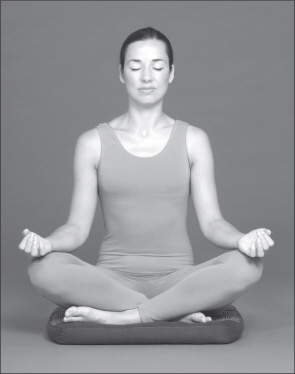
A few minutes of metta meditation before seeing a client helps to clear the mind.
Calming the Vata Mind
One of the key challenges for vatas is to concentrate the mind, as the abundance of air in the vata constitution can lead to daydreaming and worry. It is important for these individuals to enjoy the present moment and to gently bring the mind back to the breath when it begins to wander. Maintaining a regular meditation practice at the same hour and location every day can be a tremendous help in this effort. Vata persons require a grounded form of meditation, such as mantra repetition, observation of silence, or visualization. This will help them to cultivate positive seeds of faith and remove the doubt, worry, anxiety, and fear that tends to torment vata individuals. Trataka, concentration on one object, such as a steady flame, is particularly good for restless vatas in helping the mind to become one-pointed.
The powerful seed mantras of Om, Ram, and Hum are known to be especially grounding for vatas. Whenever your vata client appears to be out of balance, you may instruct them to vocally chant these mantras for a minute, and then repeat them silently. It is also useful to burn grounding and strengthening fragrances, such as patchouli, musk, myrrh, or cinnamon, or to play soothing music.
Cooling the Pitta Mind
The best form of meditation for pitta types is one that softens the mind and allows for the growth of compassion, forgiveness, and overall release. Although the sharp pitta mind excels at analysis and critical thinking, these types need to work on opening the heart, releasing anger, and letting go of control. Self-inquiry meditation techniques, such as Vedanta, Zen, and Vipassana, are recommended. Pitta individuals often have good concentration and can meditate easily, but they must take care not to turn meditation into an ambition venture.
These types should focus on cultivating peace, love, forgiveness, being noncompetitive, and leaving all judgments and frustrations aside. The yoga seed mantras that create a cool, soothing effect on the spirit are Om, Aim, Shrim, and Sham. The most suitable fragrance for balancing pitta is the sweet, cooling smell of sandalwood, which is applied to the forehead as a purification gesture before entering a temple in the blazing heat of India. Other sweet fragrances are found in the scent of flowers, including jasmine, rose, gardenia, lotus, and lavender.
Awakening the Kapha Mind
One of the greatest challenges facing kapha individuals is getting started with a regular meditation or yoga practice. The best mental approach for individuals of this nature is one that focuses on reaching established goals and maintaining a predetermined practice. The kapha tendency toward drowsiness can be countered by an unwavering determination to keep going, which becomes easier as the benefits of the practice begin to emerge. Meditating in groups can also help motivate these individuals.
Kapha individuals benefit from the bhakti devotional path of meditation, which includes chanting, singing, reading spiritual texts, and praying. Also recommended is the active meditation of karma yoga, or selflessly helping others through volunteer or charity work. While practicing meditation, kaphas should focus on breaking away from material comforts, attachment, and sentimentality. The mantra sounds of Om, Hum, and Aim can be repeated mentally or vocally to create a warm, stimulating, and energizing effect on the body.
Chanting and singing in general are highly beneficial for kaphas, as they create vibrations in the lungs and sinuses and wake up the mind. Warming and stimulating fragrances, such as camphor, eucalyptus, sage, and mint, may help to maintain focus and alertness.
Yoga and meditation are powerful practices that have traditionally played an important therapeutic role within the ancient science of Ayurveda. When practiced according to the doshic needs of each individual, these techniques have the potential to restore balance, increase mental clarity, and facilitate spiritual growth. It is not necessary to make an appointment or spend a lot of money to practice yoga or meditation—all that is required is a quiet room and a mat.
By sharing basic yoga and meditation recommendations with our recipients, the healing potential of our Thai Yoga Therapy practice expands beyond the massage room.
Now let’s consider how to enhance wellness through another ancient pillar of Ayurvedic medicine—nutrition and diet.